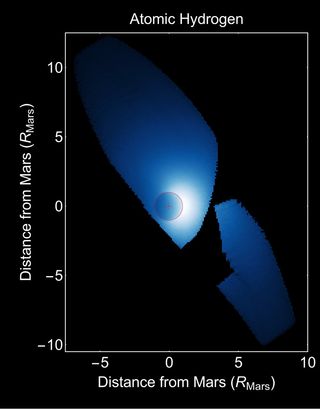New NASA Mars Probe Beams Home 'Tantalizing' 1st Results

A NASA Mars orbiter has been busy since it arrived at the Red Planet late last month.
NASA's Mars Atmosphere and Volatile EvolutioN mission (MAVEN for short) is designed to probe Mars' thin atmosphere, to help scientists understand what caused the planet to change from a warm, wet world long ago to the cold and dry one it is today. The spacecraft entered into orbit around Mars on Sept. 21, and it has already beamed back some amazing new data about Mars' upper atmosphere, researchers said.
In MAVEN's first few weeks of instrument testing at the Red Planet, scientists have already created some of the most complete maps of atomic hydrogen, oxygen, carbon and ozone in the Martian atmosphere ever made. One of MAVEN's instruments even collected data as energetic particles blasted out by a massive solar eruption made it to Mars. [See amazing MAVEN images]
MAVEN is still in the "commissioning phase" of its mission, meaning that the probe hasn't started collecting science full-time. The new data were gathered as the spacecraft's ground controllers began turning on its instruments after it arrived at Mars.

"What we're seeing so far is really just a tantalizing teaser of what's to come," MAVEN principal investigator Bruce Jakosky, of the Laboratory for Atmospheric and Space Physics at the University of Colorado, Boulder, said during a NASA news conference today (Oct. 14).

Scientists working with MAVEN weren't able to see exactly how the solar energetic particles (SEPs) affected Mars' atmosphere on Sept. 29 because the instruments necessary for that kind of observation weren't functioning in tandem at that time. MAVEN researchers expect, however, that the spacecraft's instruments will be ready to observe the atmosphere during the next Mars-directed solar event.

"After traveling through interplanetary space, these energetic particles of mostly protons deposit their energy in the upper atmosphere of Mars," SEP instrument lead Davin Larson, of the University of California, Berkeley's Space Sciences Laboratory, said in a statement. "An SEP event like this typically occurs every couple weeks. Once all the instruments are turned on, we expect to also be able to track the response of the upper atmosphere to them."
Get the Space.com Newsletter
Breaking space news, the latest updates on rocket launches, skywatching events and more!
Scientists think that solar weather events could be partially responsible for the loss of the Martian atmosphere over time.
Ground controllers are now moving MAVEN into its lower, science orbit in order to take more observations of the planet's upper atmosphere and find out how some of it might be escaping into outer space. The probe should begin its primary science mission in about two weeks, NASA officials said.
The $671 million MAVEN mission is also gearing up to watch a comet make a close flyby of the Red Planet on Oct. 19.
Comet Siding Spring is set to give Mars a close shave when it flies 87,000 miles (140,000 kilometers) by the planet. NASA's fleet of spacecraft on and around Mars are planning to make observations of the comet's flyby. MAVEN should be able to see how the comet's flyby might affect the Martian atmosphere, researchers have said.
Follow Miriam Kramer @mirikramer and Google+. Follow us @Spacedotcom, Facebook and Google+. Original article on Space.com.
Join our Space Forums to keep talking space on the latest missions, night sky and more! And if you have a news tip, correction or comment, let us know at: community@space.com.

Miriam Kramer joined Space.com as a Staff Writer in December 2012. Since then, she has floated in weightlessness on a zero-gravity flight, felt the pull of 4-Gs in a trainer aircraft and watched rockets soar into space from Florida and Virginia. She also served as Space.com's lead space entertainment reporter, and enjoys all aspects of space news, astronomy and commercial spaceflight. Miriam has also presented space stories during live interviews with Fox News and other TV and radio outlets. She originally hails from Knoxville, Tennessee where she and her family would take trips to dark spots on the outskirts of town to watch meteor showers every year. She loves to travel and one day hopes to see the northern lights in person. Miriam is currently a space reporter with Axios, writing the Axios Space newsletter. You can follow Miriam on Twitter.
